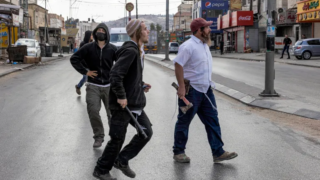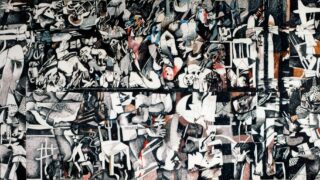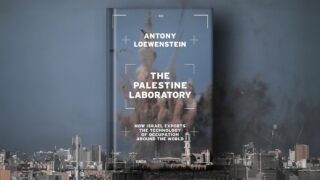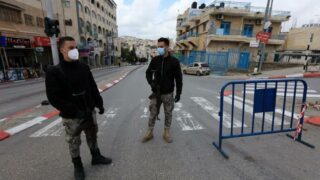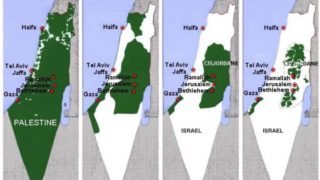It was an apparently ordinary afternoon in Nazareth, the largest Palestinian town in the 1948 territories that has remained Arab, when Abd al-Kareem Abu Saleh, cut his car across the road towards his cousin. Dragging him out of his car, Abu Saleh proceeded to bludgeon his relative to death. Shops nearby captured the incident on video. Israeli and Palestinian media circulated the footage; it soon went viral.
After Abu Saleh had killed his cousin, he returned to his car, grabbed an axe, and hacked up the body. Leaving the scene for a few minutes, he returned to stab the lifeless corpse dozens of times with a knife. The dispute that led to the murder was over a piece of land. Passers-by hurriedly fled the scene to avoid “getting involved.”
Shortly after this atrocious incident, a young man murdered his sister in Tira. A few days later, deep in the Carmel mountain the corpse of yet another girl stabbed to death was found hung alongside her fiancé. In Rahat in the Naqab, a mother killed her three children. These were just some of the violent murders that week in late September 2012 among 1948 Palestinians.
These stories are not exceptional. Far from it. They are indeed unremitting: the attacks on women’s freedom, the settling of criminal accounts, murders during robberies, years of bloodshed and interminable vendettas in family feuds, and conflicts that begin with a clash over a plot of land or a bicycle. The occurrence of such incidents only escalates, at times exposing new facets of human tragedy, at other times mere absurdity. Most take place in close social circles: the nuclear family, the extended family, or the village. They reveal the treacherous cracks in the most intimate of social relations: brother murdering brother, husband murdering wife, son murdering father, cousin murdering cousin. Such interfamilial and domestic incidents constitute the overwhelming majority of this internecine violence.
Deaths by Percent
Numbers and data can never capture the magnitude of human tragedy. In fact, they work most often to mask it. But a brief survey of some figures reveals that these incidences of brutal violence cannot be collapsed into some broader norm. They are in fact indicative of a pervasive and all-encompassing social condition with its own historical and political specificities.
As always, government data, present a disturbing but nevertheless relatively rosy picture of the depressing reality. Political leaders, social activists, social workers, and civil society organizations estimate that official figures are less than half of the violent incidents that actually occur, due to low rates of reporting, and the small police presence in Palestinian communities. Even though these statistics are inadequate and estimates involve guesswork, the figures are shocking enough.
In 2011, the authorities recorded over 1100 shooting incidents in Arab towns and villages, including sixty-two murders, which accounted for forty-one percent of murders within the Green Line—the territories under Israeli occupation since 1948. The same statistics also show that Palestinian suspects are linked to sixty-seven percent of all murders and seventy percent of all attempted murders committed in the country.
These figures relate to the 1948 Palestinians, who comprise just a fifth of the total population. In 2011 this twenty percent of the population in 1948 lands generated, in addition to the aforementioned crimes, thirty-eight percent of all assaults, fifty-two percent of arson attacks (compared to forty percent in 2009), and thirty-six percent of robberies. The figures for domestic violence are a source of black humor comes in. Since filing a police report is a social taboo, rates of violence within the family officially stand at just eleven percent.
Keep It Loaded
In 2010, the Occupation police published data that boasted of their “achievements” in eradicating weapons from 1948 Palestinian towns. They had reportedly seized five hundred pistols and two hundred rifles, fifty explosive devices, and 80,000 bullets. It was the joke of the season. These numbers are a mere drop in the treacherous ocean engulfing Palestinian communities. The fifty explosive devices are nothing compared to the actual stock, according to social and political leaders. As for the 80,000 bullets, one young man claimed: “they aren’t even enough to fire in the air during the wedding season.”
Firearms are ubiquitous in every small town in the Galilee, the Triangle, and the Naqab. The Israeli government tries to lay the blame on smugglers from Egypt and Jordan. But the lion’s share come from the following sources: raids on Israeli army weapons caches, guns captured from soldiers, or most commonly, arms exchanged for drugs with Israelis.
And these weapons are not limited to pistols and rifles. Over the last two years there have been two incidents of rocket fire using the Light Anti-tank Weapon (LAW), one in Taybeh and the other in the Galilee village of al-Rama. In a television interview, a police spokesperson listed the low prices of firearms: 750 US dollars for a pistol, 1500 US dollars for a rifle, and 3,000 US dollars for an automatic weapon. As one young man commented sarcastically, “They are the tourist prices; the Arabs always pay less.” Another said, “At our school you can buy a used pistol for two hundred dollars.”
In many towns and villages even children boast of carrying weapons. Arms have become a class marker of sorts; they reflect power, prestige, and rank. Families pride themselves on possessing heavier weaponry; light weapons are no longer the exclusive preserve of gangs and larger families.
A “cultural trait”?
“Police inaction” is the magic euphemism the Arab political leadership deploys when referring to the causes of violence. The police have not disclosed any further details of the sixty percent of murders committed among Palestinians in the 1948 territories. Investigations are conducted perfunctorily with no serious intent of arresting the perpetrators, particularly when the victims are women. Instead, the Occupation police assume the role of the watchful shepherd of this “cultural trait” of Palestinian society.
The Israeli colonialist perspective about the Palestinian space and social life as a backward and uncivilized zone result in the police’s comfortable and deeply disturbing distance before and after violent incidents occurs. Such a “cultural trait” is totally absent and does not constitute an advantage for the Palestinians in the fields of education, media and institutions, to name few among many other fields. In al-Rama, which has a population of just eight thousand, there have been around twenty murders whose perpetrators have yet to be identified.
The authorities, first and foremost the police, have failed to take any serious measures to put an end to the menace of violence. Their inaction does not merely maintain the status quo, but exacerbates it. There is a salient argument that people who carry firearms, or know someone who does, make: the police and the government do not uphold their rights. “You may have been wronged, and one of them may have shot at your house, your wife and your children. Do you think the police will protect you? You’ve got to be able to protect yourself and your family.”
Arrested Development
The economy is a critical factor in the violence, with the rate of unemployment standing at forty percent among men and eighty percent among women. Sixty-five percent of Palestinian children live below the poverty line, as do fifty percent of all Palestinians.
But the economic situation cannot explain everything. The crisis of identity and violent interruption of normal everyday life during and after the Nakba has produced a social crisis. This crisis will flourish as long as the state maintains its settler-colonial character. The disintegration of the rural infrastructure based on patriarchal clan hierarchies, the total devastation of the Palestinian city, and dependence on the colonizer’s crumbs have destroyed the existing social fabric.
The Palestinians did not become part of the Israeli state, its citizenship, or civilian life. The 1948 Palestinians do not feel that “the state,” a strange term they use to avoid saying Israel, is responsible for protecting them. They do not feel that the same police who demolish their homes, kill or oppress them are also capable of protecting them against gunfire or safeguarding their dignity. They do not believe that courts are able to deliver justice on disputes over land when it is those same courts that appropriate that very same land.
The political parties who accuse the police of “inaction” forget that they were, rightly, the first to accuse police recruits—as members of the Occupation police—of collaboration and collusion. But pointing the finger of blame at the Occupation is far easier than confronting those who bear arms and naming the known criminals who live in every Palestinian town and village. When families took to the streets to protest violence and firearms following the murder of a young man in his early twenties in the village of Jedaideh in the Acre district, armed men opened fire on them. The politicians do not dare speak out against the criminals. But the criminals have no qualms about threatening the politicians, especially the local ones. It is no secret that many families have used firearms to increase their influence in local councils and municipalities. Some crime families have even managed to take over the local councils of certain towns.
Thus Palestinian political and social institutions face a contradiction. The idea of “fighting” crime necessitates collusion with the Occupation. What remains are those awareness-raising campaigns that civil society institutions, and occasionally municipalities run. Their effectiveness is limited and they do not reach the real sites of crime. They do not offer solutions to the underlying problems. And like all NGO campaigns in Palestine, they rely on sloganeering and preach to the converted. In an act of incredible cynicism, the municipality of Umm al-Fahem appointed a sheikh from the Islamic Movement who had committed a murder in the town to organize an “anti-violence tent” in the town centre.
This is just a snapshot of an impoverished and disenfranchised people under the yoke of a Zionist rule that is obsessed with militarization, that arms itself with killing machines, and that gives the use and circulation of these weapons free reign.
Translated by Jadaliyya

